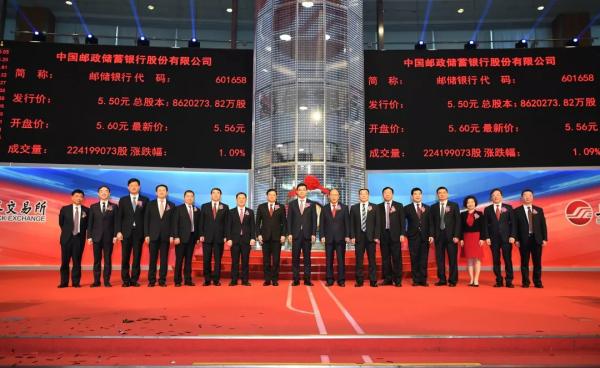Postal Business: 8610 11185
Postal Savings: 8610 95580
Logistics and EMS: 8610 11183
China Post Life: 8610 4008909999
 |
Today, the Postal Savings Bank of China (PSBC) ushers in another important milestone in its history. The A shares of Postal Savings Bank of China are officially listed on the Shanghai Stock Exchange under the stock code 601658, marking the completion of the H-share and A-share dual listings of all large State-owned commercial banks in China. It is reported that the IPO price of PSBC is 5.5 yuan (about $0.78) per share, the amount of funds raised before the green shoe option is 28.45 billion yuan (about $4.05 billion), and it is expected to ultimately bring in 32.71 billion yuan (about $4.66 billion) if choosing to exercise a green shoe option.
The listing of PSBC on the A-share market has received widespread attention in the capital market. According to the relevant announcement issued by the Bank on the Shanghai Stock Exchange, all six strategic placement funds including China Asset Management Co., Harvest Fund, China Universal Asset Management Co, E Fund Management Co, China Merchants Fund (CMF) Management Co, and China Southern Fund showed up and made full subscriptions. Together with Social Security Fund and Central SOEs Industrial Investment Fund for Poor Area, they become the eight strategic investors in PSBC’s A-share IPO. Other investors include four large State-owned banks, namely Industrial and Commercial Bank of China (ICBC), Agricultural Bank of China (ABC), Bank of China (BOC), and China Construction Bank (CCB), and three major telecommunication operators, namely China Unicom, China Telecom, China Mobile, and the provincial and municipal enterprise annuities and occupation pension plans in Shandong, Beijing, Hunan and other provinces (municipalities). It is understood that 99.5% of the offline subscription has been paid market-oriented offering projects since this year.
Moreover, according to the previous announcement of the Bank, the long-term institutional investors were eventually allocated up to 87% of the total amount of offline issuance, reflecting the firm confidence of these investors in the Bank and highlighting the high recognition of various parties to the investment value of PSBC.
On December 8, PSBC announced that China Post Group, the parent company of PSBC, planned to invest at least 2.5 billion yuan (about $0.35 billion) to increase its holding of A shares in the banking subsidiary within 12 months starting from December 10, 2019. The plan to increase stakes reflects the firm faith of China Post Group in the future development prospects of the Bank, its full recognition of the value of PSBC, and the continual optimism of the parent company towards the long-term investment value of the domestic capital market. This measure helps improve investor confidence and maintain market stability, it also shows the responsibility of China Post Group as a "national team" of the industry and its care for small and medium investors.
Thanks to its clear strategic positioning of retail banking, PSBC has always maintained sound growth. According to the PSBC A-share prospectus, as of the end of June 2019, the Bank had nearly 40,000 business outlets, covering 99 percent of cities and counties in China, which ranks first in China’s banking industry. The number of its individual clients exceeded 600 million, accounting for more than 40% of China's total population. Its total assets reached 10.07 trillion yuan (about $1.42 trillion), ranking fifth in China's banking industry. From January to June 2019, its operating income was 141.6 billion yuan (about $20.21 billion) with a net profit of 37.42 billion yuan (about $5.34 billion). From 2016 to 2018, the average compound annual growth rate of its operating income was 17.57%, and that of net profit was 14.76%.
At the same time, the Bank maintains its excellent asset quality. As of the end of June 2019, the non-performing loan ratio was 0.82%, less than half of the industry average. While the allowance coverage ratio reached 396.11%, more than two times higher than the industry average.
 |






